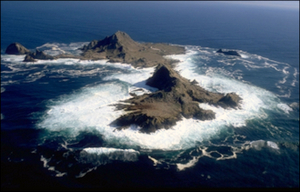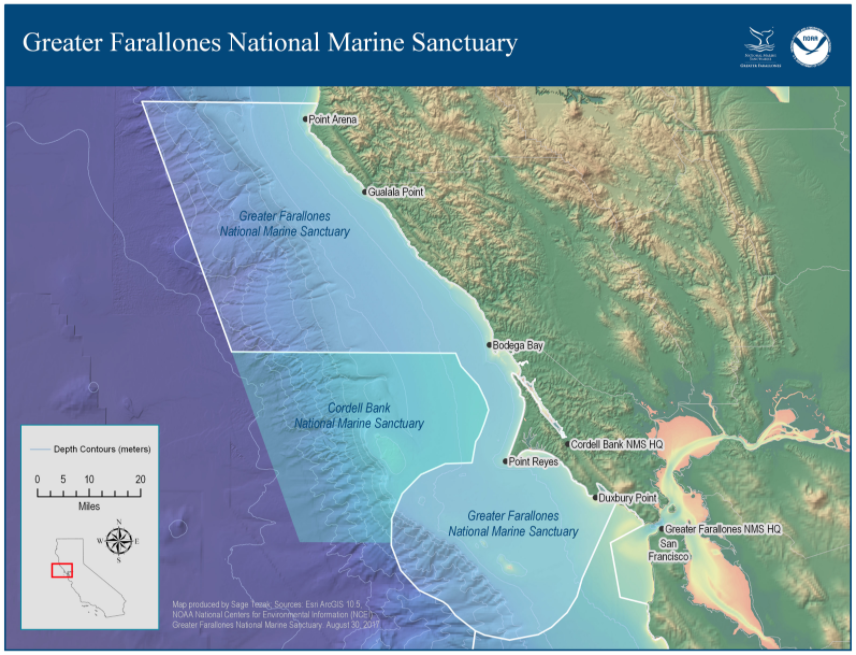Featured News
Overview
Designated in 1981, Gulf of the Farallones National Marine Sanctuary (GFNMS) spanned 1,279-square-miles (966 square nautical miles) just north and west of San Francisco Bay, and protected open ocean, nearshore tidal flats, rocky intertidal areas, estuarine wetlands, subtidal reefs, and coastal beaches within its boundaries. In 2015, GFNMS expanded north and west of their original boundaries to encompass 3,295 square miles, and changed their name to Greater Farallones National Marine Sanctuary. GFNMS has administrative jurisdiction over the northern portion of the Monterey Bay National Marine Sanctuary, from the San Mateo/Santa Cruz County line northward to the existing boundary between the two sanctuaries. GFNMS maintains an administrative office and public Visitor Center on Crissy Field in the Presidio of San Francisco. As of July 2021, GFNMS Superintendent Maria Brown also became the Superintendent for Cordell Bank NMS after the retirement of CBNMS Superintendent Dan Howard.
GFNMS was designated in 1981 because these waters provide important marine and nearshore habitats for a diverse array of marine mammals and birds in addition to fishery, plant, algal and benthic resources. The marine mammals and seabirds present in abundant numbers on the Farallon Islands and along the mainland coast depend as much on the integrity and productivity of these adjacent ocean and estuarine waters as on the preservation of the shore areas they use for breeding, feeding and hauling out.
The sanctuary contains a complete spectrum of marine habitats, ranging from unique inland estuarine and intertidal areas to pelagic and deep-oceanic environments. These productive marine environments support an abundance of living resources, including:
- at least 36 marine mammal species,
- 54 bird species that use the sanctuary during their breeding season, and
- 27 threatened or endangered species.
The sanctuary provides many examples of the marine life and habitats that are characteristic of cold temperate waters of the eastern Pacific marine region from Point Conception to British Columbia. For example:
- Some of the largest and most diverse eastern Pacific populations of seabirds and pinnipeds (seals and sea lions) south of Alaska occur here.
- Large flocks of Cassin’s Auklets, Ptychoramphus aleuticus, Common Murres, Uria aalge, Western Gulls, Larus occidentalis, and the Brown Pelican, Pelecanus occidentalis, feed on the small fishes and crustaceans that are abundant in the sanctuary’s surface waters.
- This food source also supports California’s largest breeding population of harbor seals, Phoca vitulina, as well as a growing population of northern elephant seals, Mirounga angustirostis.
- Large numbers of whales and dolphins, including the Pacific White-sided dolphin, Lagenorhynchus obliquidens, the California gray whale, Eschrichtius robustus, the endangered Pacific humpback whale, Megaptera novaeangliae, and the endangered blue whale, Balaenoptera musculus, are found in the area.
- One of the world’s largest seasonal congregations of white sharks, Carcharodon carcharias, occurs around the Farallon Islands.
- In the newly expanded region of GFNMS, iconic kelp forests have recently undergone dramatic changes and much of the bull kelp, Nereocystis luetkeana, has been severely reduced through a confluence of multiple events. Restoration efforts on these iconic kelp forests are underway.

There are also many significant nearshore habitats represented within sanctuary boundaries, such as the inland-reaching Estero de San Antonio and Estero Americano, Tomales Bay and Bolinas Lagoon, and the large intertidal and subtidal reef at Duxbury Reef. For maps, tables, and analyses of the sanctuaries’ biological resources, please see A Biogeographic Assessment off Northern and Central Califonia published by NOAA’s Center for Coastal Monitoring and Assessment.
The sanctuary illustrates how important the ocean and its wildlife and habitats are for the economic and social well-being of the region:
- The gulf region has supported large commercial fisheries, including a large percentage of the San Francisco fleet. Dungeness crab, Cancer magister, salmon, Oncorhynchus spp., and groundfish (such as sanddab, Citharichthys spp., and California halibut, Paralichthys californicus) are the top fisheries in the gulf region.
- Sport fishing also generates revenue for the party boat fleets operating out of Bodega Bay, San Francisco and Half Moon Bay.
- Whale watching and offshore excursions are other activities that have grown in popularity.
- The sanctuary contains some of the West Coast’s busiest shipping lanes.
Managing an area with such a rich abundance and diversity of marine life near the bustling San Francisco Bay Area’s nearly eight million residents brings a great number of challenges. Water quality, habitat destruction through development, wildlife disturbance, invasive species and other issues must be continually evaluated and addressed. However, the rewards and opportunities are great as well, as the sanctuary partners with many agencies, organizations and individuals to protect, study, manage and teach about this precious resource.



